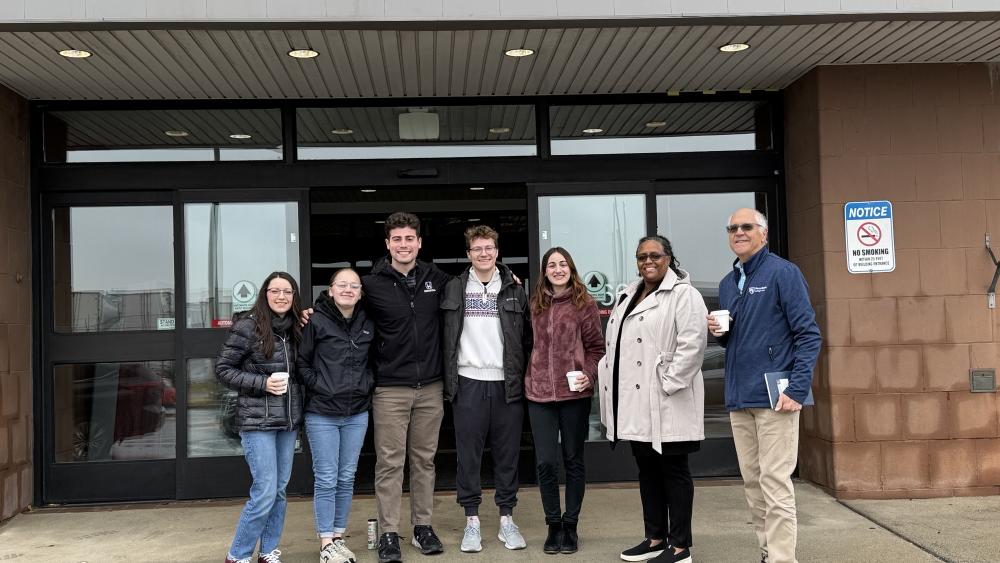Project and supply chain students visit the Port of Philadelphia – Penn State University

Report on the Partnership Between Penn State Lehigh Valley and PhilaPort in Advancing Sustainable Development Goals
Executive Summary
This report details the collaboration between Penn State Lehigh Valley’s project and supply chain management program and the Port of Philadelphia (PhilaPort). The initiative provides students with practical, industry-relevant experience, directly contributing to several United Nations Sustainable Development Goals (SDGs), including SDG 4 (Quality Education), SDG 8 (Decent Work and Economic Growth), SDG 9 (Industry, Innovation, and Infrastructure), and SDG 17 (Partnerships for the Goals). By connecting academic concepts with real-world port operations, the program prepares graduates to support sustainable economic growth and resilient infrastructure.
Fostering Quality Education and Industry-Relevant Skills (SDG 4)
The partnership exemplifies a commitment to SDG 4 by ensuring inclusive and equitable quality education and promoting lifelong learning opportunities. The program focuses on providing students with technical and vocational skills for employment and decent jobs.
Program Objectives and Outcomes
- Bridging Theory and Practice: The program, led by coordinator Mark Capofari, organizes site visits to industrial locations like PhilaPort, ALDI’s distribution center, and Volvo/Mack Trucks to “bring the textbook to life.”
- Skill Development: Students gain firsthand knowledge of complex supply chain operations, including the movement of containers, forest products, automobiles, and perishables.
- Student Empowerment: Testimonials from students, such as senior Dominic Baio, confirm that the program provides the tools, confidence, and professional networks necessary for a successful career, aligning with SDG Target 4.4 to substantially increase the number of youth and adults who have relevant skills for employment.
Driving Decent Work and Economic Growth (SDG 8)
PhilaPort’s operations and expansion are significant drivers of regional economic growth, directly supporting the objectives of SDG 8 to promote sustained, inclusive, and sustainable economic growth, full and productive employment, and decent work for all.
Economic Impact and Job Creation
- Employment: PhilaPort currently employs nearly 12,000 people and supports over 66,000 industry-related jobs across the tri-state area.
- Economic Contribution: The port generates an annual economic impact exceeding $1.5 billion, fostering economic productivity and growth in line with SDG Target 8.2.
- Future Opportunities: The recent addition of Norwegian Cruise Line operations and a 152-acre expansion project promise to create new jobs and economic opportunities, further contributing to regional prosperity.
Building Resilient Infrastructure and Sustainable Industry (SDG 9)
As a critical hub for global commerce, PhilaPort represents the type of resilient and sustainable infrastructure essential for achieving SDG 9. The port’s continuous development supports sustainable industrialization and innovation.
Infrastructure and Operations
- Scale of Operations: Spanning over 1,000 acres, PhilaPort moves more than 7 million tons of cargo annually via more than 1,100 ships, connecting to national truck and rail networks.
- Strategic Growth: The port is one of the fastest-growing on the East Coast, with its expansion described by Chairman Michael Pearson as a “generational opportunity” and a “bold investment” in the region’s future infrastructure.
- Supporting Global Commerce: The efficient flow of goods through the port is fundamental to the global economy, highlighting the importance of developing quality, reliable, and sustainable infrastructure as outlined in SDG Target 9.1.
Strengthening Partnerships for the Goals (SDG 17)
The collaboration between Penn State Lehigh Valley and PhilaPort is a model for the multi-stakeholder partnerships advocated for in SDG 17. This public-private-academic partnership is crucial for mobilizing and sharing knowledge, expertise, and technology to support the achievement of the SDGs.
Collaborative Framework
- Academic-Industry Linkage: The program establishes a direct link between an educational institution and key industry players, ensuring that academic curricula remain relevant and responsive to industry needs.
- Network Building: Students are given opportunities to interact with industry professionals, building networks that facilitate their transition into the workforce.
- Community Engagement: As noted by Ryan Abramson, Director of Strategic Communications, this partnership highlights the campus’s role within the community, telling a story of shared success and contributing to the sustainable development of the Lehigh Valley region.
1. Which SDGs are addressed or connected to the issues highlighted in the article?
- SDG 4: Quality Education – The article focuses on Penn State Lehigh Valley’s project and supply chain management program, which provides students with specialized skills and real-world learning experiences to prepare them for the workforce.
- SDG 8: Decent Work and Economic Growth – The article highlights the significant economic impact of PhilaPort, including job creation, support for industry-related employment, and its role as a driver of regional economic growth.
- SDG 9: Industry, Innovation and Infrastructure – The Port of Philadelphia is presented as a critical piece of infrastructure that is growing and expanding to support global commerce and economic development.
- SDG 17: Partnerships for the Goals – The article describes the partnership between an academic institution (Penn State) and various industry players (PhilaPort, ALDI, Crayola, Volvo/Mack Trucks) to enhance student learning and workforce readiness.
2. What specific targets under those SDGs can be identified based on the article’s content?
-
SDG 4: Quality Education
- Target 4.4: By 2030, substantially increase the number of youth and adults who have relevant skills, including technical and vocational skills, for employment, decent jobs and entrepreneurship.
Explanation: The article details how Penn State Lehigh Valley’s program provides students with practical, industry-relevant skills. It states that tours and guest speakers allow students to “graduate with the experience, networks and skills they will need to have an immediate impact” in their careers. The program is specifically designed to prepare graduates for jobs like project manager, procurement agent, and transportation specialist.
- Target 4.4: By 2030, substantially increase the number of youth and adults who have relevant skills, including technical and vocational skills, for employment, decent jobs and entrepreneurship.
-
SDG 8: Decent Work and Economic Growth
- Target 8.2: Achieve higher levels of economic productivity through diversification, technological upgrading and innovation, including through a focus on high-value added and labour-intensive sectors.
Explanation: The article describes PhilaPort as one of the “fastest-growing ports on the East Coast” and mentions its expansion by 152 acres. This growth, combined with moving over 7 million tons of diverse cargo annually, points to increasing economic productivity and diversification of operations. - Target 8.5: By 2030, achieve full and productive employment and decent work for all women and men… and equal pay for work of equal value.
Explanation: The article explicitly quantifies the port’s contribution to employment, stating that “PhilaPort employs nearly 12,000 people and supports more than 66,000 industry-related jobs.” The addition of new cruise line operations is also noted to bring “new jobs and increased economic opportunities.”
- Target 8.2: Achieve higher levels of economic productivity through diversification, technological upgrading and innovation, including through a focus on high-value added and labour-intensive sectors.
-
SDG 9: Industry, Innovation and Infrastructure
- Target 9.1: Develop quality, reliable, sustainable and resilient infrastructure, including regional and transborder infrastructure, to support economic development and human well-being…
Explanation: The Port of Philadelphia is presented as a major piece of regional infrastructure essential for economic development. The article highlights its scale (“spans more than 1,000 acres”), its function (“moves over 7 million tons of cargo annually”), its connectivity (“goods are transported by truck and rail to communities across the country”), and its ongoing development (“recently added 152 acres for future expansion”).
- Target 9.1: Develop quality, reliable, sustainable and resilient infrastructure, including regional and transborder infrastructure, to support economic development and human well-being…
-
SDG 17: Partnerships for the Goals
- Target 17.17: Encourage and promote effective public, public-private and civil society partnerships, building on the experience and resourcing strategies of partnerships.
Explanation: The article is centered on the partnership between Penn State Lehigh Valley and industry. The program coordinator “brings students to industry locations like PhilaPort so they can connect classroom concepts to practice.” The article also mentions tours of other facilities like “ALDI’s distribution center,” “the Crayola crayon manufacturing facility,” and “Volvo/Mack Trucks,” showcasing a multi-partner approach to education and workforce development.
- Target 17.17: Encourage and promote effective public, public-private and civil society partnerships, building on the experience and resourcing strategies of partnerships.
3. Are there any indicators mentioned or implied in the article that can be used to measure progress towards the identified targets?
-
SDG 4: Quality Education
- Implied Indicator for Target 4.4: The number of graduates from the project and supply chain management program who gain employment in the industry. The article implies success by stating the program provides students with “the tools and confidence I need to succeed” and prepares them for “a wide range of industry careers.”
-
SDG 8: Decent Work and Economic Growth
- Indicator for Target 8.2: Annual economic impact and cargo volume. The article provides specific figures that can be used as indicators of economic productivity: “moves over 7 million tons of cargo annually” and generates an “annual economic impact of more than $1.5 billion.”
- Indicator for Target 8.5: Number of jobs created and supported. The article provides direct figures: “PhilaPort employs nearly 12,000 people and supports more than 66,000 industry-related jobs.” The creation of “new jobs” from expansion is also mentioned.
-
SDG 9: Industry, Innovation and Infrastructure
- Indicator for Target 9.1: The scale and volume of infrastructure operations. The article provides quantifiable data points such as the port’s size (“more than 1,000 acres”), its expansion (“added 152 acres”), and the volume of traffic (“more than 1,100 ships calling on the port each year”).
-
SDG 17: Partnerships for the Goals
- Implied Indicator for Target 17.17: The number and frequency of collaborative activities between the university and industry partners. The article mentions that these opportunities “happen regularly” and lists several examples of on-site tours (PhilaPort, ALDI, Crayola, Volvo/Mack Trucks), which serves as a qualitative and quantitative measure of the partnership’s activity.
4. SDGs, Targets, and Indicators Table
| SDGs | Targets | Indicators |
|---|---|---|
| SDG 4: Quality Education | 4.4 Increase the number of youth and adults with relevant skills for employment. | Implied: Number of graduates from the supply chain program who gain employment. |
| SDG 8: Decent Work and Economic Growth | 8.2 Achieve higher levels of economic productivity. |
|
| 8.5 Achieve full and productive employment and decent work. |
|
|
| SDG 9: Industry, Innovation and Infrastructure | 9.1 Develop quality, reliable, sustainable and resilient infrastructure. |
|
| SDG 17: Partnerships for the Goals | 17.17 Encourage and promote effective public-private partnerships. | Implied: Number and frequency of joint university-industry activities (e.g., site tours to PhilaPort, ALDI, Crayola, Volvo/Mack Trucks). |
Source: psu.edu
What is Your Reaction?
 Like
0
Like
0
 Dislike
0
Dislike
0
 Love
0
Love
0
 Funny
0
Funny
0
 Angry
0
Angry
0
 Sad
0
Sad
0
 Wow
0
Wow
0




















































.jpg.webp?itok=0ZsAnae9#)


























